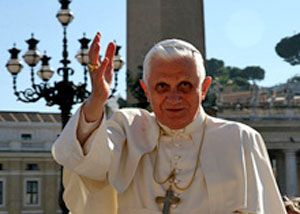|

November 11, 2009
from
DiscoveryMagazineBlogs Website

Had he lived to what would have been his
75th birthday on Monday,
Carl Sagan would’ve seen a
surprising new collaborator in pondering whether there’s life out
there in the cosmos:
the Vatican.
The Pontifical Academy of Sciences held
a conference of scientists and theologians this week that probed the
possibility of extraterrestrial life, and the peculiar religious
questions that life on other worlds would raise.
Father Jose Funes, director of the Vatican Observatory,
became the Catholic Church’s chief evangelist this week spreading
the notion that alien life is compatible with Christianity.
“This is not in contradiction with
our faith, because we cannot establish limits to God’s creative
freedom. To say it with St Francis, if we can consider some
earthly creatures as ‘brothers’ or ’sisters’, why could we not
speak of a ‘brother alien’? He would also belong to the
creation”.
[The
Guardian]
The meeting marks another step in the
Vatican’s attempt to overcome its historical reputation as
unfriendly to science and scientists.
The church held a similar
scientific conference on evolution earlier this year, and set up a
Vatican Museum exhibit to mark the 400th anniversary of Galileo’s
observations - and to make up for the church’s 17th century treatment
of him.
In 1992, Pope John Paul II declared the
ruling against the astronomer was an error resulting from “tragic
mutual incomprehension” [AP].
But while many Christians have managed to square evolution and
astronomy with non-literal interpretations of the Bible, some people
think the reconciliation won’t be so easy - like cosmologist Paul
Davies, who spoke at the conference.
“The real threat would come from the
discovery of extraterrestrial intelligence, because if there are
beings elsewhere in the universe, then christians, they’re in
this horrible bind.
They believe that God became incarnate in
the form of
Jesus Christ in order to save humankind, not
dolphins or chimpanzees or little green men on other planets,”
he says.
[Washington
Post]
|

